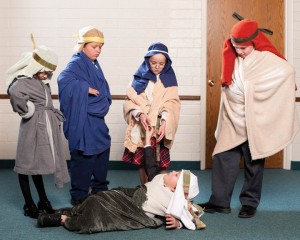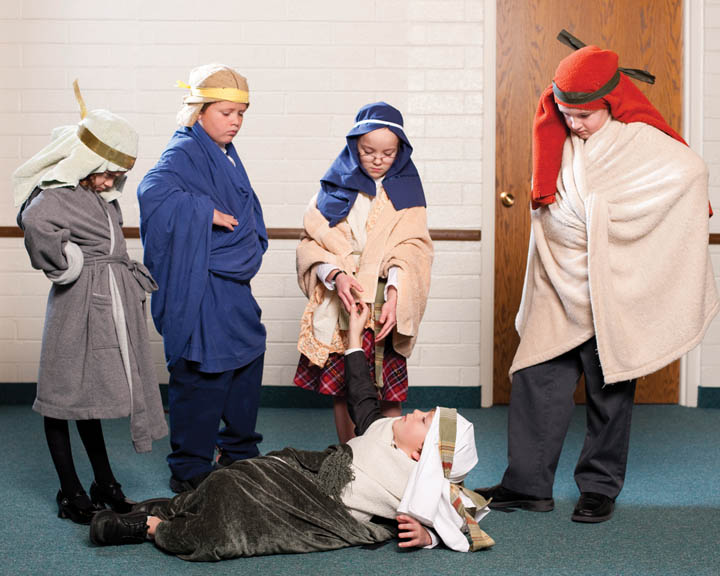A friend of another faith attended a Sunday service for the Church of Jesus Christ of Latter-Day Saints (known as the Mormons). She was surprised to see (and hear) so many children of all ages in attendance. At her church services, small children were tended in a separate room until the services were over.
 We know our children are “an heritage of the LORD…. As arrows are in the hand of a mighty man; so are children of the youth. Happy is the man that hath his quiver full of them…” (Psalms 127:3-5)
We know our children are “an heritage of the LORD…. As arrows are in the hand of a mighty man; so are children of the youth. Happy is the man that hath his quiver full of them…” (Psalms 127:3-5)
Our quiver and our pew are full, which sometimes brings its own challenges. We’ve had a three-year-old son escape from our pew and run down the aisle with the taunt, “You can’t catch me!” We’ve had hungry, fidgety and crying infants. We’ve had siblings argue over the crayons and paper that were intended to keep them occupied.
So why would we go to church weekly for the last 13 years with children in tow? Our small, wiggly children are asked to sit still during a service that would seem beyond their attention span, but we (and other members of the congregation) are willing to overlook the potential cry of a baby or the occasional whispering chatter of a toddler.
There are four things we hope to teach our children by bringing them to church:
1. Love for our Father in Heaven and the Savior, Jesus Christ
“We want our children in [sacrament meeting]. We also want them to learn reverence, which is a form of love for the Savior. We want our children to understand that this is a worship service for Jesus, where we show him we love him.” ( Report from the 161st Annual General Conference, April 6–7, 1991 W. Mack Lawrence)
By attending church every week and taking the sacrament, we renew the promises and covenants we made at baptism – our way of showing our love to our Savior. When our children are baptized at age 8, they also can renew these covenants each Sunday.
They learn to love the Savior by learning His doctrine. In the Church of Jesus Christ of Latter-Day Saints, there are Sunday classes created just for children, called Primary. They sing songs and have a lesson on a gospel principle. They go to individual classes with lessons targeted for their age. They meet with their families in sacrament meeting, where the sacrament is passed. They learn more about the Savior’s life and teachings. They learn stories from the scriptures. They learn about God’s commandments and His love for His children. They can try to be more like Him because they know Him.
2. Repentance
One day after a particularly rowdy Sunday meeting, my husband gathered the family together to teach the importance of the sacrament. With a jar of clear water, he had the kids add drops of food coloring until the water was black. We talked about how we make mistakes during the week. We work on repentance every day, but on Sunday, we also take the sacrament and renew our baptismal covenants. The kids added bleach and watched the water become clear again. It brought home the purpose of going to church every Sunday – it helps us to repent and move forward.
3. Respect for the Savior and for others
When we teach reverence during church, we teach respect for the sacrament and the Atonement of Jesus Christ. The children learn respect for others as they go to Primary classes, listen to speakers, and try to stay quiet so other people in the congregation can enjoy the meeting.
“Worship services are a tremendous opportunity for children to learn about self-control and respect for the rights and needs of others. These sacred gatherings are occasions for all of us to work together to help children learn to feel and desire the ministrations of the Holy Spirit. Then as they grow they will gain a deep, abiding love for the Savior, a love that will sustain them on the strait and narrow path back into His arms.” (Joan Hughes and Helen Hughes, “Teaching Children to Worship,” Ensign, Jan 2007, 24–27)
4. How to Feel the Holy Ghost
We want our children to learn to recognize the feelings and presence of the Holy Ghost.
“Even very small children can experience the beautiful, sacred, tender feelings bestowed by the Holy Spirit, and all children have a need and a right to do so. For our children to feel the Spirit, they need to take part in sacrament meeting and be tranquil enough to sense the whisperings of the still, small voice. It is not always easy, but we can teach our children to “be still, and know that I am God.” (Psalm 46:10).(Joan Hughes and Helen Hughes, “Teaching Children to Worship,” Ensign, Jan 2007, 24–27)
We are trying to follow Christ, who invited the little children to be with Him.
“And they brought young children to him, that he should touch them: and his disciples rebuked those that brought them. But when Jesus saw it, he was much displeased, and said unto them, Suffer the little children to come unto me, and forbid them not: for of such is the kingdom of God. Verily I say unto you, Whosoever shall not receive the kingdom of God as a little child, he shall not enter therein. And he took them up in his arms, put his hands upon them, and blessed them. “(Mark 10:13-16)
Are our children too young to learn these lessons? I don’t think so. Even our 11-month-old folds his arms on his own when we have family prayers. Every Sunday is a drop in the bucket of our child’s experience. My older children show me that bringing them to church, even as babies, was a very good choice. It isn’t easy, but it is worth the effort. We know that if we hang in there, we will be able to say as the apostle John did:
“I have no greater joy than to hear that my children walk in truth.” (3 John 1:4)


